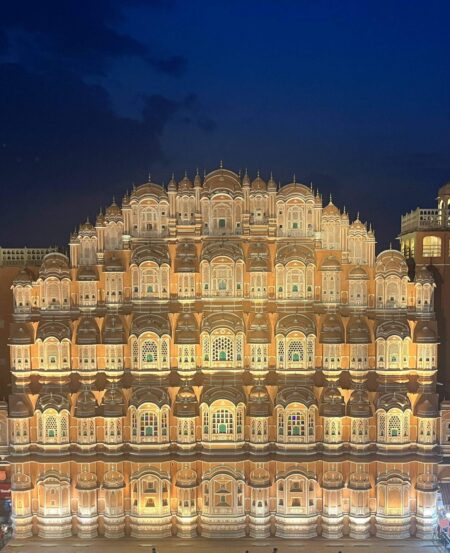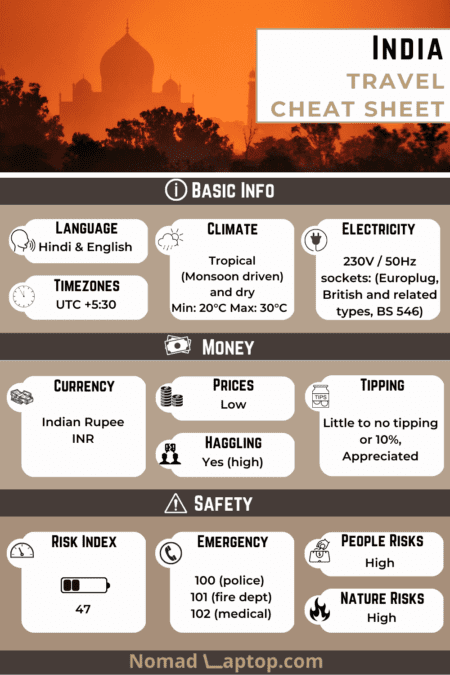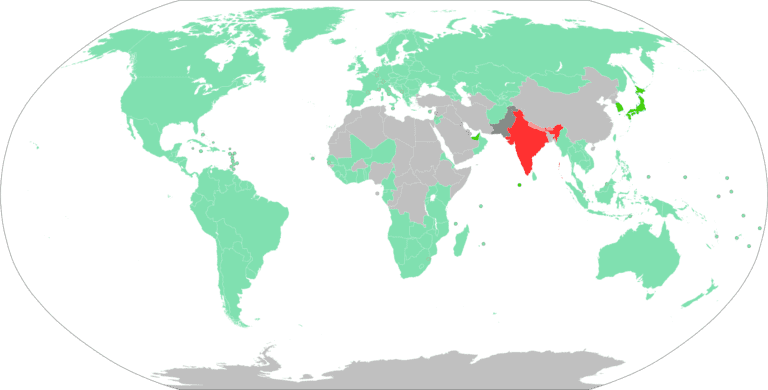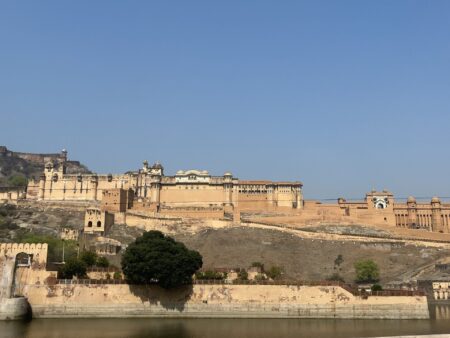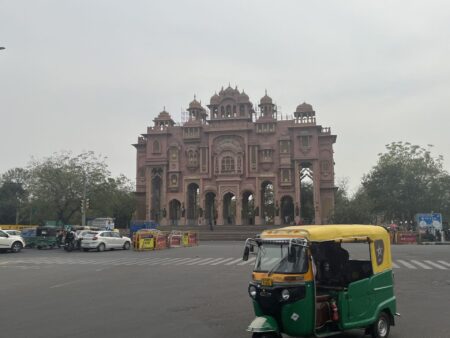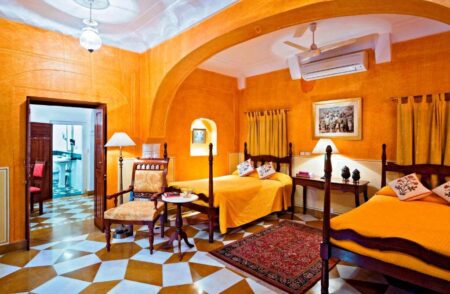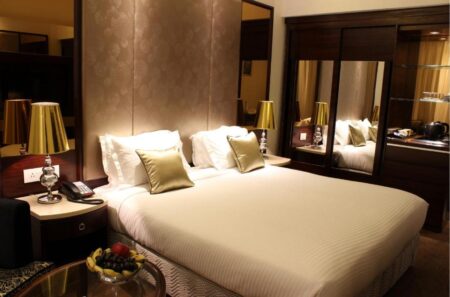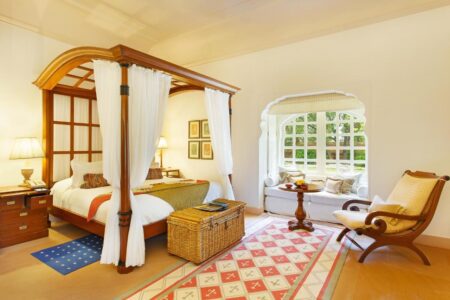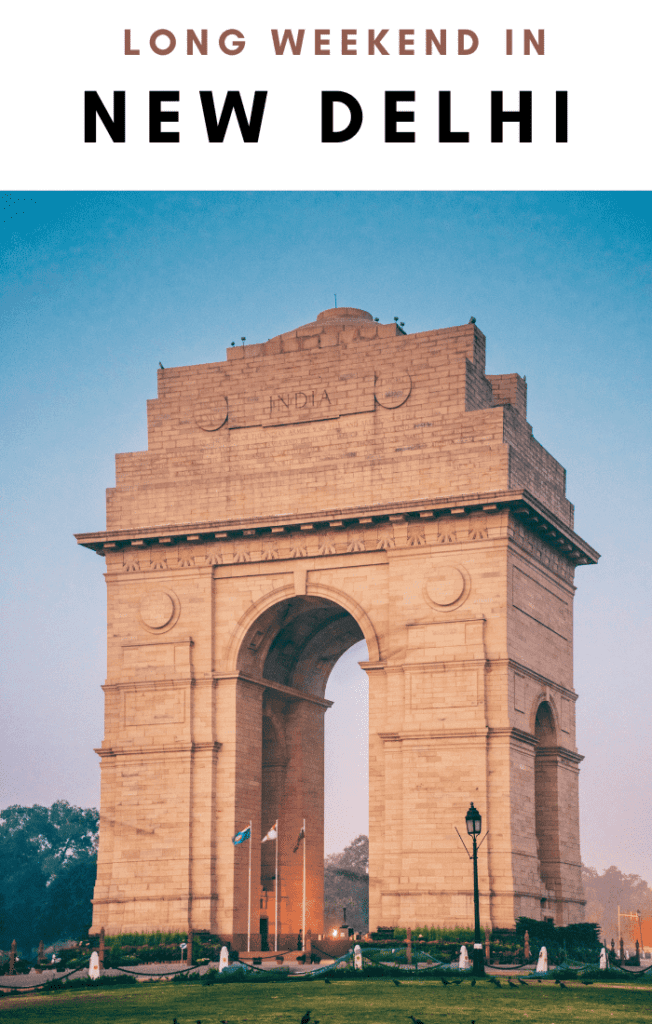Jaipur is a vibrant city in Northern India, the capital city of the state of Rajasthan, and part of the three cities of the Rajastan Golden Triangle because of its close proximity to New Delhi and Agra, making it a popular destination for tourism.
It is known for its rich history and culture and is known as ‘Pink City‘ due to the pink–colored buildings in the old city area.
Jaipur has a lot to offer, from stunning architecture to exciting cuisine, vibrant markets, and an array of cultural and historical attractions. The several forts propped on the mountains surrounding the city, such as Amer Fort, Nahargarh Fort, and Jaigarh Fort, allow for deep exploration. The palaces, such as the City Palace, Hawa Mahal, and the beautiful lake palace of Jal Mahal, offer plenty of sightseeing opportunities. Also, despite being a large Indian city, it is also possible to enjoy a peaceful getaway.

India Info & Stats
- Language: Hindi and English are the official languages.
- Population: 1.4 billion (2020 Est.)
- Timezone: UTC +5:30
- Ethnic Groups: Indo-Aryan 72%, Dravidian 25%, Mongoloid and other 3%
- Religions: 79% Hindu, 14% Muslim, 2% Christian, 2% Sikh
- Political System: Parliamentary Republic
- Currency: Indian Rupee (INR)
- Credit Cards: Credit cards are not widely used. For comparison, the average global use is around 20% and 4% in India. ATMs, though, are evenly spread around the city.
- Electricity: Socket types Europlug, British types, 230 volt / 50 hertz
- Tipping Customs: 10-15% in restaurants and taxis
- Haggling Culture: Common in markets and bazaars
Weather
Jaipur has a hot, semi-arid climate, and even in the winter months, the weather can’t be described as cold.
I visited in late March, at the end of the “best season” to visit (between October and March), and at the beginning of the summer season, and did not suffer too much from the heat itself, which was around 30 degrees heat (although during the climb up to Nahargth Fort under the sun I did smell my skin burning).
In deep summer, temperatures can reach up to a deadly 48 degrees, and I cannot begin to imagine how unbearable it would be coupled with air pollution, busy streets, and general smells.
Money
The currency is the Indian Rupee (INR).
The real-time exchange rate from US dollars is: 84 INR
Credit cards are seldom accepted, and most places will expect you to pay in cash. This goes for taxi drivers and ticket entrances, for example. ATMs are not so easy to find (for example, at the airport, there are no ATMs and drivers want to be paid in cash).
Prices: India is not expensive at all. As a visitor, especially someone who is Western and easily identifiable, you will be charged much more for everything. That being said, unless you make it a matter of principle, paying 500 rupees more amounts to 5 USD. Having a driver take you around for the whole day for around 10 dollars is convenient, even if you are paying much more as a foreigner.
Tipping: India doesn’t have a strong tipping culture. In touristic places and tourist-oriented services, it is common to leave a tip of around 10%.
Entry Requirements
There are quite some distinctions in visa requirements based on the visitor’s citizenship.
Click the map to see details on visa requirements for each country
Alternatively, input your passport citizenship and quickly see the requirements that apply to you:
Getting around
(I only used a car, an autorickshaw, and lengthy walks around, so I don’t know what the underground or bus lines are).
Jaipur has both Uber and Ola, with the latter being more convenient.
Most tourists move around either by autorickshaw or taxi. The two are mostly interchangeable, with tuk-tuks being cheaper and more “characteristic” while cars clearly offer better comfort and air conditioning.
If you want to experience chaos in one of its purest forms, rent a car or motorbike and drive yourself.
Walking around is also doable, as much of the city is mostly flat. That being said, you will be exposed to a lot of dirty streets, fumes, manure, trash, etc., as well as smog and unclean air. Also, you will have to have your wits about you when it comes to the chaotic and out-of-control traffic. Finally, if you have a distinctive western appearance or, in general, are clearly a tourist who doesn’t blend in much, be prepared to be stopped a lot for various friendly chit chats, offers to drive you around, to go see someone’s uncle’s shop, etc.
Safety
Safety: Tourism is very safe in Jaipur (notwithstanding the general precautions for female travelers and members of the LGBTQ community). As in many places in India, there are a lot of scams and a perceivable high risk of pickpocketing, but all and all safe.
Health safety is a major concern for foreigners as the waters are notoriously filthy and the risk of debilitating stomach flu is very high. I did not experience any, but was also very cautious since I was traveling on a tight schedule and could not afford to be sick which would have not only ruined my stay but potentially jeopardized future movements.
Natural risks: India is prone to earthquakes, floods, and severe storms which routinely hit the country, and Jaipur is subjected to these as well.
Emergencies number: 112, 100 (police), 101 (fire department), 102 (emergency medical services), 108 (emergency)
Tips & Impressions
- I was not surprised but still, the street traffic was shocking, both traveling on foot or inside a car or rickshaw. All this chaos makes you really see the several cows, calmly prancing among the streets, as sort of divine enlightened beings. How they do not have heart attacks after a day of walking through the streets still amazes me.
- Unfortunately, I have to highlight this negative: as a solo traveler and tourist, I’m used to being approached by locals who want to work and maximize their income. Scams are common, as is the simple overpricing of goods and services for foreigners. That is normal and I have the privilege of not needing to always budget, so I don’t mind paying more for a taxi or all the other common things done for tourists. It’s part of the thing. However, as I wrote in my city escape overview, I like to spend at least some time blending in. I do not have the presumption to think that I can actually blend in, but at least be part of a city without being so recognizable or doing all the touristy things. Unfortunately, in Jaipur, I was not able to walk around or even stop anywhere for that matter, as I would get approached constantly by everyone. While visiting as a tourist, constant offers for guides Again, this is all normal, but it sort of starts to grind on you when done nonstop. Not being able to admire a palace during sightseeing because of all the guides in your way At entrances, all attempts are made to “explain” how entrance for foreigners works so that you would think that your only choice is the (inflated full tour included) ticket price. Same thing for walking around. It is already quite a challenge to traverse the streets; it is even harder when the dozens of autorickshaws stop in front of you, blocking your way, offering you a ride and you have to swim through them like additional obstacles. Clearly, the same happens with random people on the street, stopping you, some physically holding you, all to lure you into their or their uncle’s shop. All this had the consequence that I did not enjoy walking around and observing people, as I usually do. I always tend to refuse anything that is offered, but I will listen, make clear my intentions, and not lead on, but remain friendly. Seeing the mannerisms, the way people talk, knowing how to politely refuse something, etc. is all part of getting to know a country, even if you are staying for a very short time as a tourist. But here, unfortunately, I didn’t do any of this. I just walked around without turning to anyone who would call me or engage with me. Sometimes in a very rude way, like making your way in a club filled with people who stand in your way. It all seemed necessary but certainly took away from the enjoyment.
- Because of what I wrote above, I was also much more on edge when it came to safety, independently from the actual concrete risks. I think it may have to do with this feeling of always being harassed in some way. Always know that there are many eyes on you, waiting for you to pass near them or directly approach them, even if there is no risk at all and that they are just vendors like everywhere in the world. I guess it was just a matter of sheer numbers and frequency.
Deals for Jaipur
Where to stay
Luxury
Boutique & Eco-friendly
Travelogue
- Day 1
- City walk
- Amer Fort
- Jal Mahal
- Hawa Mahal
- City Palace
- Day 2
Accommodation

My accommodation was Bloom Boutique Hotel. The hotel is in an almost 300-year-old building right next to the City Palace and Hawa Mahal. As such it is by no means new or particularly clean, but had all the needed comforts and friendly staff, as well as the mandatory tourist helper guy who could arrange tours, drives, tickets, and such.
The proximity to the City Palace is its most attractive characteristic, and it is right in the middle of the Pink City. The rooftop allowed for fascinating views of other rooftops, the bustling streets underneath, and several monkeys in the morning playing around and going about their business.
Day 1
I had some small difficulties reaching the hotel the night before (despite the airport being so very safe, I did not want to hail a random cab and went to a kiosk to book my driver, which needed to be paid upfront in cash but the airport had no ATMs so I wandered a bit and found a money exchange where I spent half an hour filling out forms to exchange 50 dollars).
The next morning I was awoken by the Muezzin chants of morning prayers and the cacophony of the streets. After having enjoyed the company of playful monkeys on the rooftop of my hotel I started my touristic sightseeing tour.
The first day I moved around by car so it was easy and pleasant. I stopped at the iconic Water Palace and then proceeded to the famous Amer Palace. Despite it being very crowded there was always a room, corridor, or pathway to follow in the sprawling palace, allowing for a wonderful exploration of the interiors. The nearby stepwell is also a sight to behold and its architecture seems to have been taken directly by one of Escher’s works (or probably the other way around).
I took a break and in the late afternoon visited the City Palace next to my hotel and the imposing wall of Hawa Mahal. I spent the evening on a rooftop bar at the Tattoo Cafe right in front of Hawa Mahal and enjoyed the beautiful view during the sunset and night with the Palace illuminated.
Day 2
The next day I was prepared to walk up to Nahargth Fort, a 1h walk from my hotel. The city chaos became a bit too hard for my senses at the end, with me venturing through some of the least clean parts of town and suffering a bit from it.
I stopped to rest in Gaitor Ki Chhatriyan, where the tombs of the Maharajas are. This wonderful small garden is a tiny sliver of heaven tucked away in the bustling city. It was calm and peaceful, with no other visitors and beautiful, large monuments with intricate marble carvings. I highly recommend visiting this, at the very least to experience a touristic destination that is calm and peaceful and distinctly “out of place” compared to the rest.
After having caught my breath I embarked on the climb towards the fort which was strenuous. Madhvendra Palace, inside the fort walls, has a routinely changed exposition of sculptures and each of the many many rooms (dozens and dozens of rooms on 3 floors) had something different and was wonderful to explore.
I traversed the entire city on auto rickshaw to the south near the airport, to enjoy more green spaces in Jawahar circle and admire the imposing Patrika Gate. This very recent construction is well known and is an architectural wonder, imposing itself over the entire large plaza. Each column of the gate itself has wonderful depictions of historical, cultural, and architectural images of different parts of Rajasthan.


